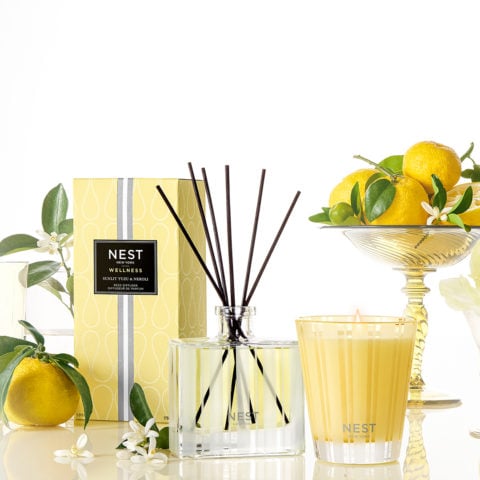How to Deal with “Maskne”
Here’s how to fight face-mask breakouts, straight from the pros

It’s been a few months since face masks became a regular part of our lives. Whether you’ve made your own thanks to the many DIY tutorials available on YouTube, bought a few cute cloth options from Etsy or gone the disposable route, face masks have definitely become a large part of the “new normal” that everyone keeps talking about.
Since some cities, including Toronto, have recently passed a bylaw making masks mandatory in indoor public spaces until at least September, if you’re not already accustomed to mask life (to which we must say: ugh), you’re about to be.
And while the pros of wearing a mask are hopefully obvious (they save lives, they’re not actually uncomfortable, they mean you don’t have to put on lipstick in the morning and—once more for the people in the back—they save lives), now that we’re wearing them so often, many of us are also experiencing a con: mask-induced breakouts and minor skin irritations due to prolonged wear.
So if you’ve noticed an increase in breakouts and pimples around your mouth, nose and chin area, you’re not alone. We reached out to the pros to learn more about maskne, including, most importantly, how to treat and prevent it.
What is “maskne”?
“Maskne is technically known as ‘acne mechanica,’” says Dr. Monica Li, dermatologist and clinical instructor in the Department of Dermatology and Skin Science at the University of British Columbia. “It’s acne that arises at sites of friction, pressure, occlusion or rubbing, causing irritation and inflammation of the hair follicles.” Before the days of COVID-19, you might have noticed acne mechanica along your hairline after a hot, sweaty day in a baseball cap, for instance. It’s also often “seen in athletes who wear sporting equipment such as helmet straps,” says Dr. Li. “Acne mechanica [is also] due to…increased heat and moisture underneath the masked area, which causes pores to clog, adding to acne flare-ups.”
Are hot summer days making it worse?
“The enclosed area of the mask against our skin unfortunately produces a microenvironment of warm moisture,” says dermatologist Dr. Carl Thornfeldt. When combined with summer’s hot, humid weather, “this super-hydrates the stratum corneum (the outer layer of the skin) and dilates the pores and sweat glands.” This increased oil and sweat production clogs our pores, resulting in maskne.
What other types of skin issues can we expect to see?
Because maskne is typically inflammatory in nature and caused by those aforementioned clogged pores, it usually presents itself in the form of whiteheads. However, since it’s 2020 and the worst-case scenario is never really out of the question, it can “evolve to become pustular and cystic lesions,” says Dr. Li.
If you’re noticing things like rosacea or contact dermatitis, you might have a slight allergy to the fabric or dyes in your face mask, which may be worth a virtual consultation with a dermatologist.
Already breaking out? Here’s how to treat maskne.
Turn to the trusty acne-fighting ingredients that you’d use for any other breakout. Ingredients like salicylic acid, benzoyl peroxide and retinoids are common in over-the-counter and prescription skincare products and can save the day. “These ingredients can be found in both cleansers and moisturizers,” says Dr. Li. “Keep in mind, though, that acne treatments can dry [out] the skin, so it’s about finding the fine balance of tolerating these ingredients [while managing] the ongoing irritation that can come from mask wear.” Finding this balance is unique to your skin type and lifestyle, of course, but incorporating these products into your nighttime skincare regimen a few times a week (not several days in a row) is usually the safest bet.
“The use of gentle cleansers and moisturizers can help to repair and restore skin-barrier integrity, which may be compromised due to friction from use of facial masks and coverings,” says Dr. Li. Of course, if a breakout is severe or doesn’t go away with treatment, reach out to your dermatologist or family physician to see what’s going on.
Is there any way to prevent maskne while wearing a mask?
So you got your last breakout under control and now you want to prevent it from happening again? Great! The most important step you can take is to practice good hygiene. This means washing your face in the morning and the evening and washing your mask regularly (if it’s a cloth mask). You want to make sure your skin is always coming into contact with a fresh, clean mask.
When it comes to your summer skincare routine, opt for lighter textures like gels and lotions rather than thick creams, which can further clog pores. For those who had acne-prone skin before the recent use of masks and facial coverings, you already know that skincare products containing topical salicylic acid, benzoyl peroxide or retinoids (such as retinol, tretinoin or retinyl acetate) can help to unclog pores and reduce oiliness of the skin, says Dr. Li. But, as mentioned above, it’s about striking a balance between gently exfoliating the skin to prevent a buildup of skin cells and debris and not further irritating the skin by overusing chemical exfoliants.
Does wearing makeup under a mask have an impact?
Sure does! “Wearing makeup can further occlude facial skin under a mask and contribute to acne development,” says Dr. Li. Not wearing makeup like foundation and concealer on mask-covered skin is an easy way to help prevent breakouts. If you absolutely must wear makeup, “choose mineral-based products rather than oil-based ones, as the latter are more occlusive,” says Dr. Li. “Consider alternatives such as tinted moisturizer or tinted sunscreen,” she adds, rather than a full-coverage foundation.
Here are five products we recommend for treating and preventing maskne this summer.
Formulated with salicylic acid, this cleanser not only treats existing breakouts but prevents new ones from starting. Bonus: You can also use it on your body to treat pesky back and chest acne that can pop up in the summer months.
Cetaphil Gentle Skin Cleanser, $11.99, beauty.shoppersdrugmart.ca
This dermatologist-recommended iconic face cleanser is soap- and irritant-free and hydrates skin as it gently cleanses. If you’re experiencing irritation or sensitivity, this is always a great option.
Vichy Deep Purifying Cleansing Gel, $14.99, beauty.shoppersdrugmart.ca
Specifically formulated for acne-prone skin, this gel cleanser is oil-free and soap-free, so it doesn’t strip the skin of its natural oils, keeping it hydrated while treating and preventing breakouts thanks to salicylic acid.
CeraVe Salicylic Acid Lotion for Rough & Bumpy Skin, $16.99, well.ca
Not only is this daily moisturizing lotion formulated with acne-fighting salicylic acid, but it also features lactic acid to help with overall skin tone and texture, as well as ceramides, hyaluronic acid and niacinamide (vitamin B3) to help restore and maintain the skin barrier and keep your skin hydrated throughout the day.
Glossier Solution, $29, glossier.com
Need an extra acne-clearing step in your routine? Glossier’s Solution is made with a 10% blend of AHAs, BHAs and PHAs to gently but effectively unclog pores and slough off the built-up dead skin cells that can cause breakouts.








